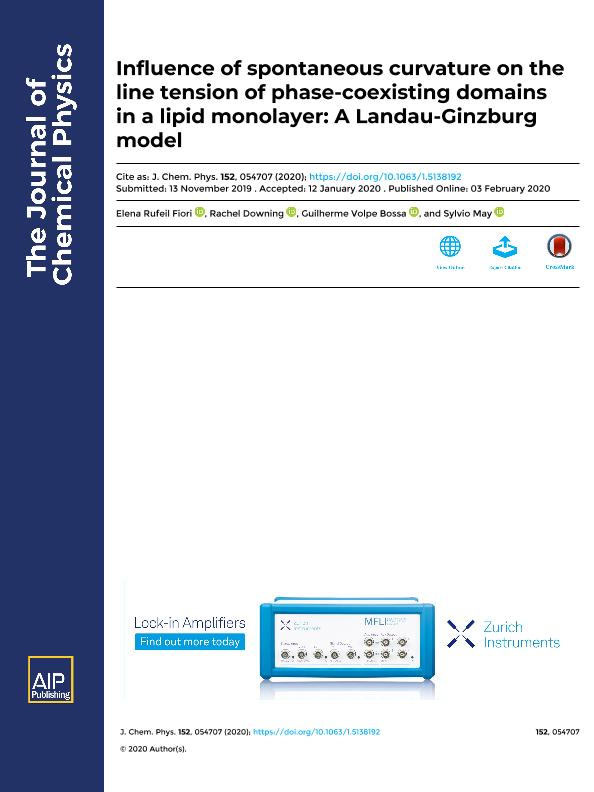Mostrar el registro sencillo del ítem
dc.contributor.author
Rufeil Fiori, Elena

dc.contributor.author
Downing, Rachel
dc.contributor.author
Bossa, Guilherme Volpe
dc.contributor.author
May, Sylvio
dc.date.available
2021-07-30T13:18:38Z
dc.date.issued
2020-02-03
dc.identifier.citation
Rufeil Fiori, Elena; Downing, Rachel; Bossa, Guilherme Volpe; May, Sylvio; Influence of spontaneous curvature on the line tension of phase-coexisting domains in a lipid monolayer: A Landau-Ginzburg model; American Institute of Physics; Journal of Chemical Physics; 152; 5; 3-2-2020; 54707-54717
dc.identifier.issn
0021-9606
dc.identifier.uri
http://hdl.handle.net/11336/137438
dc.description.abstract
The line tension between two coexisting phases of a binary lipid monolayer in its fluid state has contributions not only from the chemical mismatch energy between the two different lipid types but also from the elastic deformation of the lipid tails. We investigate to what extent differences in the spontaneous curvature of the two lipids affect the line tension. To this end, we supplement the standard Landau-Ginzburg model for the line tension between coexisting phases by an elastic energy that accounts for lipid splay and tilt. The spontaneous curvature of the two lipids enters into our model through the splay deformation energy. We calculate the structure of the interfacial region and the line tension between the coexisting domains numerically and analytically, the former based on the full non-linear model and the latter upon employing an approximation in the free energy that linearizes the resulting Euler-Lagrange equations. We demonstrate that our analytical approximation is in excellent agreement with the full non-linear model and use it to identify relevant length scales and two physical regimes of the interfacial profile, double-exponential decay, and damped oscillations. The dependence of the line tension on the spontaneous curvatures of the individual lipids is crucially dependent on how the bulk phases are affected. In the special case that the bulk phases remain inert, the line tension decreases when the difference between the spontaneous curvatures of the two lipid types grows.
dc.format
application/pdf
dc.language.iso
eng
dc.publisher
American Institute of Physics

dc.rights
info:eu-repo/semantics/openAccess
dc.rights.uri
https://creativecommons.org/licenses/by-nc-sa/2.5/ar/
dc.subject
LINE TENSION
dc.subject
LIPID MONOLAYER
dc.subject
LANDAU-GINZBURG MODEL
dc.subject.classification
Física Atómica, Molecular y Química

dc.subject.classification
Ciencias Físicas

dc.subject.classification
CIENCIAS NATURALES Y EXACTAS

dc.title
Influence of spontaneous curvature on the line tension of phase-coexisting domains in a lipid monolayer: A Landau-Ginzburg model
dc.type
info:eu-repo/semantics/article
dc.type
info:ar-repo/semantics/artículo
dc.type
info:eu-repo/semantics/publishedVersion
dc.date.updated
2021-07-01T15:23:30Z
dc.journal.volume
152
dc.journal.number
5
dc.journal.pagination
54707-54717
dc.journal.pais
Estados Unidos

dc.journal.ciudad
Melville
dc.description.fil
Fil: Rufeil Fiori, Elena. Consejo Nacional de Investigaciones Científicas y Técnicas. Centro Científico Tecnológico Conicet - Córdoba. Instituto de Física Enrique Gaviola. Universidad Nacional de Córdoba. Instituto de Física Enrique Gaviola; Argentina
dc.description.fil
Fil: Downing, Rachel. North Dakota State University. Department Of Physics.; Estados Unidos
dc.description.fil
Fil: Bossa, Guilherme Volpe. Universidade Estadual Paulista Julio de Mesquita Filho; Brasil
dc.description.fil
Fil: May, Sylvio. North Dakota State University. Department Of Physics.; Estados Unidos
dc.journal.title
Journal of Chemical Physics

dc.relation.alternativeid
info:eu-repo/semantics/altIdentifier/url/https://aip.scitation.org/doi/10.1063/1.5138192
dc.relation.alternativeid
info:eu-repo/semantics/altIdentifier/doi/https://doi.org/10.1063/1.5138192
Archivos asociados
